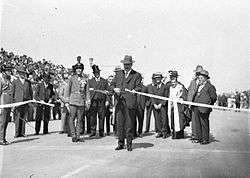Samuel Walder
| The Honourable Sir Samuel Walder | |
|---|---|
 | |
| 59th Lord Mayor of Sydney | |
|
In office 1 January 1932 – 31 December 1932 | |
| Preceded by | Joseph Jackson |
| Succeeded by | Richard Hagon |
| Alderman of the Sydney City Council | |
|
In office 1 December 1924 – 31 December 1927 | |
|
In office 18 June 1930 – 5 December 1941 | |
| Member of the Legislative Council of New South Wales | |
|
In office 8 September 1932 – 22 April 1943 | |
| Personal details | |
| Born |
Samuel Robert Walder 8 October 1879 Sydney, Colony of New South Wales |
| Died |
24 November 1946 (aged 67) Woollahra, New South Wales, Australia |
| Political party |
Civic Reform Association United Australia Party |
| Spouse(s) | Elsie Blunt |
| Religion | Church of England |
Sir Samuel Robert Walder (8 October 1879 – 24 November 1946) was an Australian politician who was Lord Mayor of Sydney and a member of the New South Wales Legislative Council.[1]
Early years and background
Samuel Robert Walder was born in Sydney, Colony of New South Wales, on 8 October 1879, the son of Mary Ann (Hatton) and Samuel Walder, a sail-maker. After being educated at Cleveland Street Public School and Christ Church St Laurence Parish School, Walder left school at age 13 and entered his father's sail, tent and tarpaulin manufacturing business as an apprentice. When his father died, the 18-year-old Walder took over as manager.[1] Under his management, Walder expanded the business and was floated as a Limited company, S. Walder Ltd, in 1911. On 22 March 1911 Walder married Elsie Helena Blunt, a milliner, at St Martin's Anglican Church, Kensington. They had a daughter and a son. During the First World War Walder's company obtained a government contract to supply tents to the Australian Army.[2] With the success of his company, Walder expanded his business activities, becoming a director of the local board of Eagle Star and British Dominions Fire Insurance Company, Lowe Brothers, Monsoon Waterproofing Company and as the chairman of directors of Sargents Limited.[3] In 1924 he retired as managing director of S. Walder Ltd, which remained a family company.[1]
Political career and later years
A prominent member of the Sydney community, being a member of the Sydney Chamber of Manufactures, Chamber of Commerce and the Master Retailers Association, Walder stood for, and was elected to, the Sydney City Council at a by-election for Flinders Ward as candidate for the Civic Reform Association, on 1 December 1924. Walder served as an alderman until 1927, when the council was dismissed, and was elected for Macquarie Ward in 1930, when the council was returned. He was the Secretary of the Citizens' Reform Association from 1925 to 1941.[2] On 9 December 1931, Walder was elected by the council as Lord Mayor of Sydney, noting that he had "realised the ambition of my life".[4] Taking office in 1932, Walder led the council during the worst year of the Great Depression and chaired the Citizens' Employment Committee, which assisted citizens in obtaining employment.[1] The civic improvements and events undertaken during his tenure included the extension of Martin Place to Macquarie Street, the unveiling of the Archibald Fountain on 14 March 1932 and the opening of the Sydney Harbour Bridge on 19 March 1932. On 2 January 1933, he was made a Knight Bachelor for his service as Lord Mayor.[5]

As Lord Mayor, Walder was given a life appointment to the New South Wales Legislative Council from 8 September 1932. However, with the abolition of life appointments and the introduction of indirect elections to the council in 1933, Walder was elected as a member on 21 November 1933.[3] An active philanthropist along with his wife, in 1933 he donated £100 towards an initiative to build houses for the financially distressed.[6] He was also a director of Royal Prince Alfred Hospital from 1933 to 1935 and a member of the Rotary Club of Sydney.[1] As a vice-president of the liberal conservative National Association of New South Wales in 1930 and a member of the committee that negotiated the creation of the United Australia Party, of which he was a vice-president in 1933–1939, Walder sat for the UAP in the Legislative Council until his defeat in April 1943.[3]
During World War II he chaired Sydney City Council's National Emergency Services committee, advocating the construction of underground air-raid shelters and other measures preparing for possible attack.[1] He served as an Alderman until his retirement in December 1941.[2] Survived by his wife, son and daughter, he died of cancer on 24 November 1946 at Woollahra and was buried in Waverley Cemetery.
References
- 1 2 3 4 5 6 Spearritt, Peter. "Walder, Sir Samuel Robert (1879–1946)". Australian Dictionary of Biography. Australian National University. Retrieved 15 March 2013.
- 1 2 3 "Samuel Walder". Sydney's Aldermen. City of Sydney. Retrieved 1 April 2013.
- 1 2 3 "Sir Samuel Robert WALDER (1879–1946)". Former Members. Parliament of New South Wales. Retrieved 1 April 2013.
- ↑ "Lord Mayor of Sydney – Alderman Walder Elected". The Barrier Miner. 10 December 1931. Retrieved 1 April 2013.
- ↑ "WALDER, Samuel Robert". It's an Honour database. Australian Government. Retrieved 1 April 2013.
- ↑ "Sir Samuel Walder, Gift of £100 to Relieve Distress". The Sydney Morning Herald. 26 January 1933. Retrieved 1 April 2013.
| Civic offices | ||
|---|---|---|
| Preceded by Joseph Jackson |
Lord Mayor of Sydney 1932 |
Succeeded by Richard Hagon |